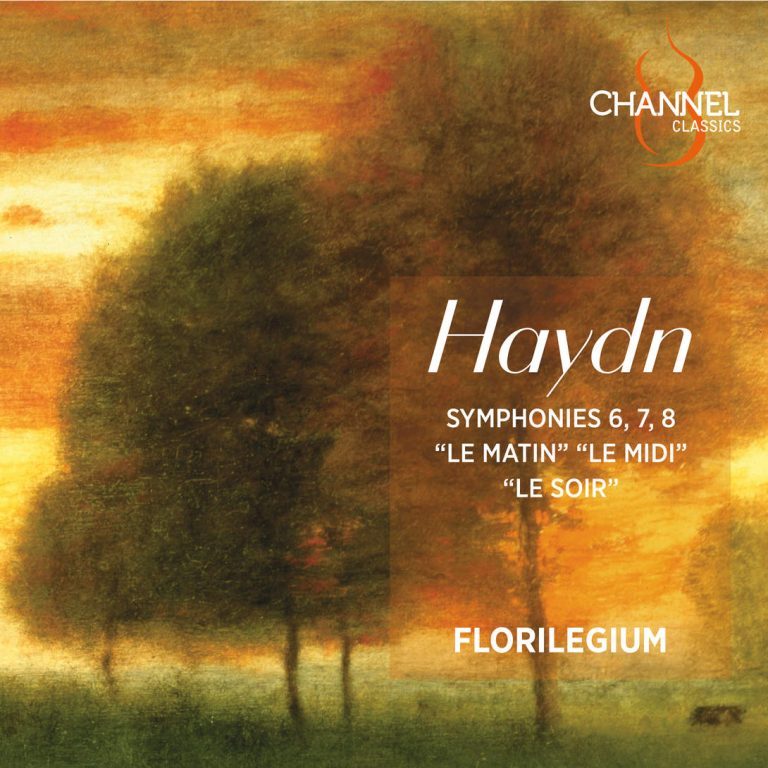De Symfonieën no. 6, 7 en 8 van Joseph Haydn werden uitgebracht door het bijzondere, Britse ensemble Florilegium o.l.v. Ashley Solomon.
English version below
Joseph Haydn componeerde de Symfonieën no. 6, 7 en 8 voor zijn opdrachtgever Paul Anton Esterházy, een jaar voor diens dood in 1761. Deze drie werken refereren respectievelijk aan de Ochtend, de Middag en de Avond. Ze zijn zogezegd programmamuziek. Composities waar de componist werd geïnspireerd door een buitenmuzikaal gegeven en hierdoor een verhalend karakter hebben. Iets soortgelijks kwamen we al tegen in de Vier Jaargetijden uit 1723 van Vivaldi. Een wijze van componeren die in de 19de eeuw verder wordt ontwikkeld tot het Symfonische Gedicht, met werken als Peter en de wolf van Prokofiev, De tovenaarsleerling van Dukas, De Moldau van Smetana, The Planets van Holst, Prélude à l’après-midi d’un faune en La Mer van Debussy.
Joseph Haydn componeerde 108 symfonieën. Op zijn 29ste schreef hij No. 6, 7 en 8 en liet zich daarbij dus inspireren door de drie dagdelen. Alhoewel dat niet heel erg goed is gelukt en er nauwelijks muzikale uitingen te vinden zijn van de ochtend, middag of avond, zijn het toch drie prachtige composities. Niet in de laatste plaats omdat de werken zo zijn gecomponeerd dat alle instrumentalisten solistisch aan bod komen en kunnen schitteren en stralen op viool, fluit, hoorn, fagot of contrabas. Belangrijk, want de 18 musici, destijds allemaal volledig in dienst bij Esterházy, moesten worden uitgedaagd en geïnspireerd tot het spelen van bijzondere muziek.
Het Florilegium speelt deze drie symfonieën ook met 18 musici, dus in de dezelfde omvang en instrumentale bezetting zoals Haydn het componeerde en bedoeld heeft. Wat het eerst opvalt in deze opname is de hechte dialoog die de musici met elkaar voeren. Dat maakt de muziek compact en komt het timbre en de cohesie ten goede. Het ensemble klinkt warm, contrastrijk en maakt optimaal gebruik van dynamische kleuringen. De uitvoeringen van het Florilegium stralen liefde en respect uit voor deze tijdloze stukken. De muziek geeft een warm gevoel van welbehagen, waarmee je met gemak de dag doorkomt; de ochtend, de middag en de avond. En de volgende dag beginnen we gewoon weer van vooraf aan….!
English version
The Symphonies no. 6, 7 and 8 by Joseph Haydn were performed by the special British ensemble Florilegium, conducted by Ashley Solomon.
Joseph Haydn composed the Symphonies no. 6, 7 and 8 for his patron Paul Anton Esterházy, a year before his death in 1761. These three works refer respectively to the Morning, the Afternoon and the Evening. They are, so to speak, program music. Compositions where the composer was inspired by an extern musical element and therefore these pieces have a narrative character. We already encountered something similar in Vivaldi’s Four Seasons, from 1723. A way of composing that was further developed in the 19th century into the Symphonic Poem, with works such as Peter and the Wolf by Prokofiev, The Sorcerer’s Apprentice by Dukas, The Vltava by Smetana, The Planets by Holst, Prélude à l’après-midi d ‘un faune & La Mer by Debussy.
Joseph Haydn composed 108 symphonies. When he was 29, he wrote No. 6, 7 and 8 and was therefore inspired by the three parts of the day. Although that didn’t work out very well and there are hardly any musical expressions to be found from the morning, afternoon or evening, these compositions are still very beautiful. Also because these symphonies are composed in such a way that all instrumentalists are featured as soloists and can shine on the violin, flute, horn, bassoon or the double bass. Important, at the time these 18 musicians were all fully employed by Esterházy. They had to be challenged and inspired to play special music.
The Florilegium also plays these three symphonies with 18 musicians, so in the same size and instrumental line-up as Haydn composed and intended. The first thing that strikes in this recording, is the close dialogue between the musicians. That makes the music compact and benefits the timbre and cohesion. The ensemble sounds warm, rich in contrast and makes optimal use of dynamic colours. The versions of the Florilegium radiate love and respect for these timeless pieces. The music brings a warm feeling of well-being, with which we can easily get through the day; the morning, the afternoon and the evening. And the next day we just start all over again….!
Florilegium: Haydn Symphonies 6, 7, 8 Le Matin, Me Midi Le Soir (Channel Classics)
© Mattie Poels.


Geen reacties